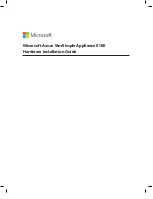
887
Configuring IP Unicast Routing
Configuring BFD
Enabling BFD Routing Protocol Clients
After you configure BFD parameters on an interface, you can start a BFD session for one or more routing protocols. You
must first enable routing by entering the
ip routing
global configuration command on the switch. Note that there can be
more than one way to start a BFD session on an interface, depending on the routing protocol.
Configuring BFD for OSPF, page 887
Configuring BFD for IS-IS, page 888
Configuring BFD for BGP, page 890
Configuring BFD for EIGRP, page 891
Configuring BFD for HSRP, page 892
Configuring BFD for OSPF
When you start BFD sessions for OSPF, OSPF must be running on all participating devices. You can enable BFD support
for OSPF by enabling it globally on all OSPF interfaces or by enabling it on one or more interfaces.
Configuring BFD for OSPF Globally
BEFORE YOU BEGIN
Configure BFD parameters as described in the
Configuring BFD Session Parameters on an Interface, page 886
Configure OSPF as described in the
.
DETAILED STEPS
To disable OSPF BFD on all interfaces, enter the
no bfd all-interfaces
router configuration command.To disable it on an
interface, enter the
no ip osfp bfd
or the
ip ospf bfd disable
interface configuration command on the interface.
If you want to run OSPF BFD on only one or a few interfaces, you can enter the
ip ospf bfd
interface configuration
command on those interfaces instead of enabling it globally. See the next procedure.
Command
Purpose
1.
configure terminal
Enter global configuration mode.
2.
router ospf
process- id
Specify an OSPF process, and enter router configuration mode.
3.
bfd all-interfaces
Enable BFD globally on all interfaces associated with the OSPF
routing process.
4.
exit
(Optional) Return to global configuration mode if you want to
disable BFD on one or more OSPF interfaces.
5.
interface
interface-id
(Optional) Specify an interface, and enter interface configuration
mode.
6.
ip ospf bfd
disable
(Optional) Disable BFD on the specified OSPF interface. Repeat
Steps 5 and 6 for all OSPF interfaces on which you do not want to
run BFD sessions.
7.
end
Return to privileged EXEC mode.
8.
show bfd neighbors
[
detail
]
Verify the configuration.
9.
copy running-config
startup-config
(Optional) Save your entries in the configuration file.
Summary of Contents for IE 4000
Page 12: ...8 Configuration Overview Default Settings After Initial Switch Configuration ...
Page 52: ...48 Configuring Interfaces Monitoring and Maintaining the Interfaces ...
Page 108: ...104 Configuring Switch Clusters Additional References ...
Page 128: ...124 Performing Switch Administration Additional References ...
Page 130: ...126 Configuring PTP ...
Page 140: ...136 Configuring CIP Additional References ...
Page 146: ...142 Configuring SDM Templates Configuration Examples for Configuring SDM Templates ...
Page 192: ...188 Configuring Switch Based Authentication Additional References ...
Page 244: ...240 Configuring IEEE 802 1x Port Based Authentication Additional References ...
Page 298: ...294 Configuring VLANs Additional References ...
Page 336: ...332 Configuring STP Additional References ...
Page 408: ...404 Configuring DHCP Additional References ...
Page 450: ...446 Configuring IGMP Snooping and MVR Additional References ...
Page 490: ...486 Configuring SPAN and RSPAN Additional References ...
Page 502: ...498 Configuring Layer 2 NAT ...
Page 770: ...766 Configuring IPv6 MLD Snooping Related Documents ...
Page 930: ...926 Configuring IP Unicast Routing Related Documents ...
Page 976: ...972 Configuring Cisco IOS IP SLAs Operations Additional References ...
Page 978: ...974 Dying Gasp ...
Page 990: ...986 Configuring Enhanced Object Tracking Monitoring Enhanced Object Tracking ...
Page 994: ...990 Configuring MODBUS TCP Displaying MODBUS TCP Information ...
Page 996: ...992 Ethernet CFM ...
Page 1066: ...1062 Using an SD Card SD Card Alarms ...
















































